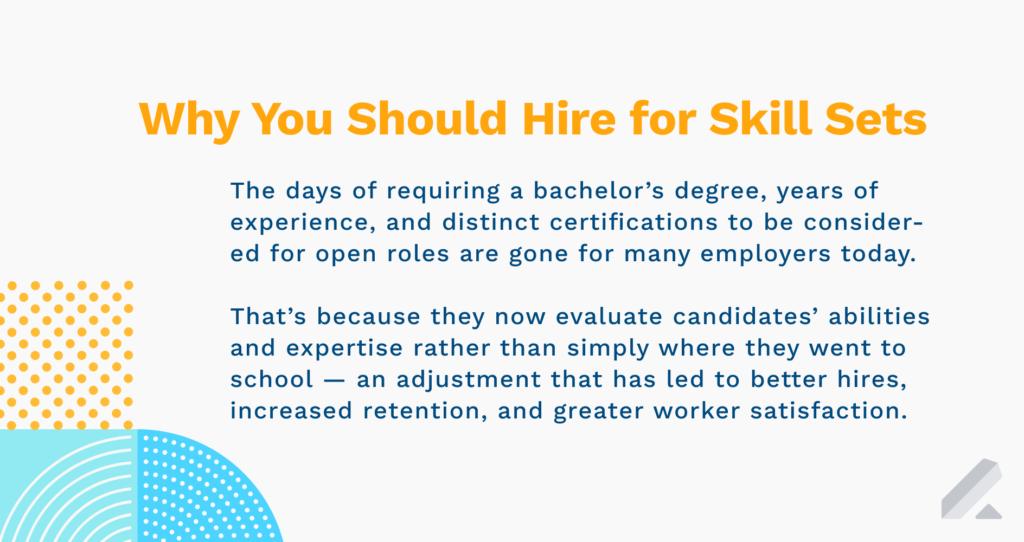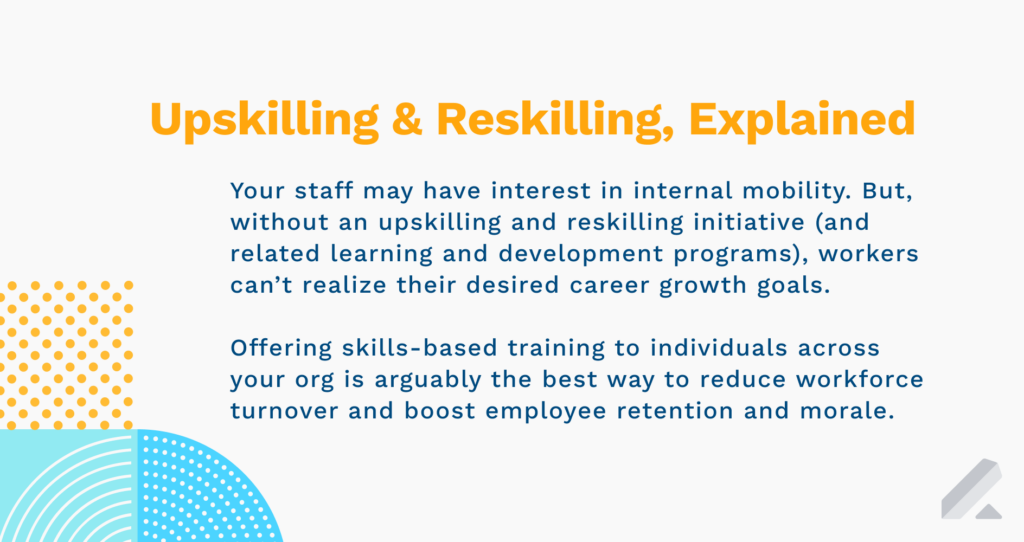The hiring process isn’t just about filling vacancies quickly and efficiently. (Although that is important). It’s about finding the right talent with the right skills to drive substantial and sustainable business growth.
One approach that’s gaining considerable traction is skills-based hiring, which, as the term suggests, focuses on a candidate’s skills rather than their formal qualifications.
A big reason for this growing interest in skills-based hiring among employers today?
Requiring a four-year degree is increasingly questioned by companies, many of which find simply having a bachelor’s degree doesn’t automatically mean “high-quality hire.”

The benefits of skills-based hiring
For employers, the benefits of this approach are becoming increasingly clear.
TA and hiring managers broaden talent pool
Talent acquisition teams and hiring managers tends to find entry-level positions challenging to fill as many candidates lack four-year college degrees or relevant work experience.
But, with a skills-based hiring program in place, the focus shifts mostly from qualifications to abilities, which opens the doors to a wider and more diverse talent pool.
Job candidates like being evaluated based on skills
And it’s clear job candidates (particularly younger ones) want to join businesses where their skills — not just their years of experience and schools they attended — are valued.
A 2022 TestGorilla report found 73% of professionals who joined a company following a skills-based hiring process said they’re happy with their job and employer. That compares to just 3% of such hires who said they were dissatisfied.
Degrees don’t automatically lead to strong hires
In today’s digital age, a degree doesn’t always guarantee that a candidate possesses the required skills to get the job done. By adopting and embracing a skills-based recruiting strategy, employers can save costs on training and employee onboarding in the long run.
“Candidates [hired based on skill sets] require little training, therefore, saving time within the onboarding process leading to contributing to productivity expeditiously,” Visual Connections HR Manager Charissa Cromwell wrote for Forbes.
Diversity and inclusion often improved with approach
Another compelling advantage of skills-based hiring practices is that it can help businesses get a more diverse, inclusive workforce on board.
“While skills-based hiring alone does not guarantee diversity, it is a necessary first step in breaking down potential barriers and creating a more inclusive organization,” a group of DEI consultants recently wrote for Bain & Company.
By shifting the focus to job seekers who can be deemed “skilled through alternative routes” (or STARs), employers like yours can tap into a largely underutilized talent pool and even enhance diversity and inclusion in the workplace.

Transitioning to a skills-based hiring approach
All in all, countless business leaders and talent acquisition experts are championing this approach, recognizing its potential to revolutionize hiring today.
LinkedIn’s CEO went so far as to call for a “skills-first” mentality across all employers, urging them to shift away from signals like degree or pedigree to hire the best people.
Heck, even the CIA is even subtly moving to identify candidates with “requisite knowledge, skills, and abilities” rather than focusing on formal and traditional qualifications.
Now, the question is: How can you adopt a skills-based hiring process, since shifting to the approach can be a game-changer for your company?
With that in mid, here are five practical tips to help you make a smooth transition.
1) Identify key skills for each role
Start by analyzing the roles within your company and identify the skills that are most relevant to each job. This can be done through a combination of job documentation review, expert interviews, chats with hiring managers, and observation of employees performing their work.
Once you’ve identified the key skills, you can include them in your job descriptions and ads.
2) Invest in an advanced ATS
Leveraging advanced recruiting tech can make your transition to skills-based hiring smoother.
Look for recruitment and hiring platforms that allow you to create dynamic candidate profiles (i.e., ones that auto-updated as new actions are taken internally or by candidates) and see a comprehensive list of a candidate’s skills.
This will help you match the right candidate to the optimal opening at your org far faster. (Not to mention help you build and sustain relationships with them using just a single candidate engagement platform, not multiple tools.)

3) Train your entire hiring team
Make sure your hiring team knows the benefits of implementing a skills-based hiring approach and understands how they can contribute to evaluating and engaging top talent.
Provide training and resources to help them shift to a skills-based hiring mindset from traditional hiring practices. Emphasize the importance of assessing prospects based on their areas of expertise, rather than degrees or previous titles.
4) Revise your job descriptions
To attract the right candidates, your job descriptions should highlight the skills required for the job, rather than listing degrees or years of experience as prerequisites. This not only broadens your talent pool but also encourages a more diverse group of candidates to apply.
Lever customers tend to produce these impact job descriptions to detail the typical skill sets required to execute for a given role (e.g., time or project management, liaising with agencies and vendors, analyzing certain data types).
5) Give candidates’ skills assessments
Doing so will help you get a clearer picture of a candidate’s abilities, including their hard and soft skills and what skills gaps at your org their expertise may be able to fill.
This could include technical tests, situational judgment tests, or problem-solving exercises.
Such assessments can give you concrete evidence of a candidate’s abilities and competencies and, thereby, help you and hiring managers make more informed hiring decisions.

Reaping the rewards of skills-based hiring
“Employers … recognize that with the current talent shortage, skills-based hiring is the best approach for a wide range of roles with significant high-volume need and higher-than-average turnover,” Opportunity@Work Head of People and Culture Angela Briggs-Paige told SHRM.
And Angela is right. Effectively transitioning to this approach means you can better position your company to attract, hire, and retain top talent in today’s competitive market.
Remember, though:
It’s not just about changing the way you hire, but also about creating a diverse and inclusive work environment where every individual has the opportunity to contribute and succeed based on their skills and abilities.
At the end of the day, a more serious effort in skills-based hiring would involve analyzing each job and gathering both qualitative and quantitative data by reviewing job documentation, interviewing experts, observing employees on the job, and administering surveys.
This data can then be used to structure new job descriptions around observed skills and, in turn, continue to augment and evolve your org’s distinct skills-based hiring approach.
Bottom line: It’s (well past) time to put skills at the forefront of your hiring process.
Learn how our ATS + CRM can accelerate your recruiting and hiring strategies. Schedule a demo of LeverTRM today to discover the power of our talent acquisition suite.



